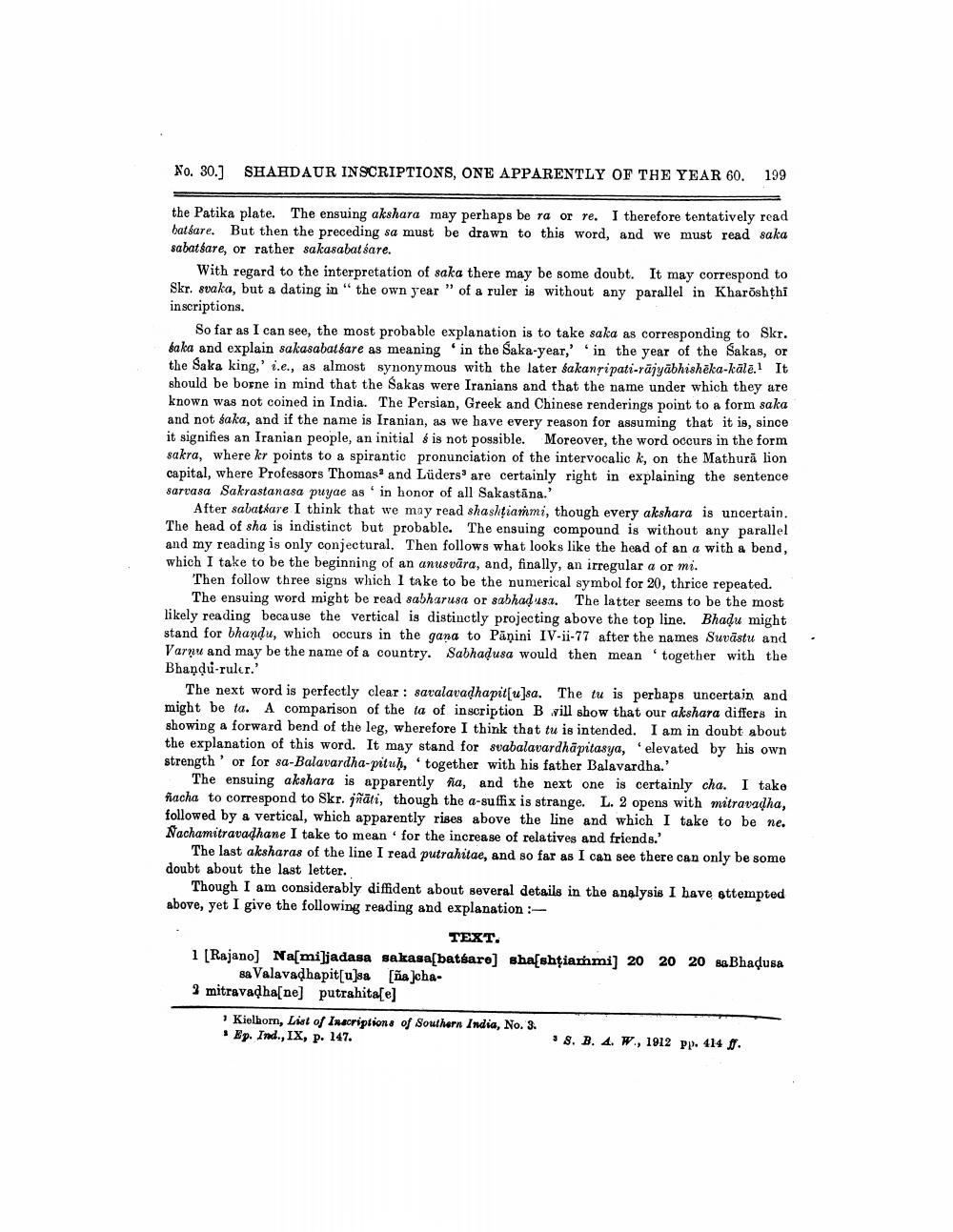________________
No. 30.] SHAHDAUR INSCRIPTIONS, ONE APPARENTLY OF THE YEAR 60. 199
the Patika plate. The ensuing akshara may perhaps be ra or re. I therefore tentatively read bat fare. But then the preceding sa must be drawn to this word, and we must read saka sabatéare, or rather sakasabat sare.
With regard to the interpretation of saka there may be some doubt. It may correspond to Skr. svaka, but a dating in the own year " of a ruler is without any parallel in Kharoshthi inscriptions.
So far as I can see, the most probable explanation is to take saka as corresponding to Skr. baka and explain sakasabattare as meaning in the Saka-year,' in the year of the Sakas, or the Saka king,' i.e., as almost synonymous with the later sakansipati-rājyäbhisheka-käle. It should be borne in mind that the Sakas were Iranians and that the name under which they are known was not coined in India. The Persian, Greek and Chinese renderings point to a form saka and not saka, and if the name is Iranian, as we have every reason for assuming that it is, since it signifies an Iranian people, an initial & is not possible. Moreover, the word occurs in the form sakra, where kr points to a spirantic pronunciation of the intervocalic k, on the Mathurā lion capital, where Professors Thomas and Lüders are certainly right in explaining the sentence sarvasa Sakrastanasa puyae as in honor of all Sakastāna.'
After sabatkare I think that we may read shashtianmi, though every akshara is uncertain. The head of sha is indistinct but probable. The ensuing compound is without any parallel and my reading is only conjectural. Then follows what looks like the head of an a with a bend, which I take to be the beginning of an anusvāra, and, finally, an irregular a or mi.
Then follow three signs which I take to be the numerical symbol for 20, thrice repeated.
The ensuing word might be read sabharusa or sabhadu81. The latter seems to be the most likely reading because the vertical is distinctly projecting above the top line. Bhadu might stand for bhandu, which occurs in the gana to Pāṇini IV-11-77 after the names Suvāstu and Varnu and may be the name of a country. Sabhadusa would then mean together with the Bhandu-ruler.'
The next word is perfectly clear: savalavadhapitfu]sa. The tu is perhaps uncertain and might be ta. A comparison of the ta of inscription B vill show that our akshara differs in showing a forward bend of the leg, wherefore I think that tu is intended. I am in doubt about the explanation of this word. It may stand for svabalavardhāpitasya, 'elevated by his own strength' or for sa-Balavardha-pituh, together with his father Balavardha.'
The ensuing akshara is apparently fia, and the next one is certainly cha. I tako facha to correspond to Skr. jñāti, though the a-suffix is strange. L. 2 opens with matravadha, followed by a vertical, which apparently rises above the line and which I take to be ne. Nachamitravadhane I take to mean for the increase of relatives and friends.
The last aksharas of the line I read putrahitae, and so far as I can see there can only be some doubt about the last letter.
Though I am considerably diffident about several details in the analysis I have attempted above, yet I give the following reading and explanation :
TEXT. 1 [Rajano] Na[mi]jadasa sakasa[batsare] sba[shtiarmi) 20 20 20 saBhadusa
sa Valavadhapit[u]sa [ña Joha3 mitravadha[ne] putrahita[e]
Kielhorn, List of Inscriptions of Southern India, No. 3. • Ep. Ind., IX, p. 147.
38. B. 4. W., 1912 PP. 414 ff.




